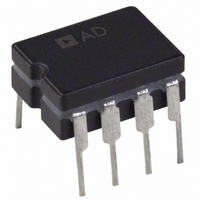OP270EZ Analog Devices Inc, OP270EZ Datasheet - Page 12

OP270EZ
Manufacturer Part Number
OP270EZ
Description
IC OPAMP GP 5MHZ DUAL PREC 8CDIP
Manufacturer
Analog Devices Inc
Specifications of OP270EZ
Slew Rate
2.4 V/µs
Rohs Status
RoHS non-compliant
Amplifier Type
General Purpose
Number Of Circuits
2
Gain Bandwidth Product
5MHz
Current - Input Bias
5nA
Voltage - Input Offset
10µV
Current - Supply
4mA
Voltage - Supply, Single/dual (±)
±4.5 V ~ 18 V
Operating Temperature
-40°C ~ 85°C
Mounting Type
Through Hole
Package / Case
8-CDIP (0.300", 7.62mm)
Op Amp Type
Low Noise
No. Of Amplifiers
2
Bandwidth
5MHz
Supply Voltage Range
± 4.5V To ± 18V
Amplifier Case Style
DIP
No. Of Pins
8
Channel Separation
175
Common Mode Rejection Ratio
125
Current, Input Bias
5 nA
Current, Input Offset
1 nA
Current, Supply
4 mA
Impedance, Thermal
12 °C/W
Number Of Amplifiers
Dual
Package Type
CDIP-8
Resistance, Input
0.4 Megohms (Differential), 20 Gigaohms (Common-Mode)
Temperature, Operating, Range
-40 to +85 °C
Voltage, Gain
2300 V/mV
Voltage, Input
±12.5 V
Voltage, Noise
3.6 nV/sqrt Hz
Voltage, Offset
10 μV
Voltage, Output, High
+13.5 V
Voltage, Output, Low
-13.5 V
Voltage, Supply
±15 V
Output Type
-
Current - Output / Channel
-
-3db Bandwidth
-
Lead Free Status / RoHS Status
Contains lead / RoHS non-compliant
Available stocks
Company
Part Number
Manufacturer
Quantity
Price
Company:
Part Number:
OP270EZ
Manufacturer:
PMI
Quantity:
5 510
Company:
Part Number:
OP270EZ/FZ
Manufacturer:
PMI
Quantity:
5 510
Company:
Part Number:
OP270EZ/FZ
Manufacturer:
NAIS
Quantity:
5 510
OP270
APPLICATIONS INFORMATION
VOLTAGE AND CURRENT NOISE
The OP270 is a very low noise dual op amp, exhibiting a typical
voltage noise density of only 3.2 nV/√Hz at 1 kHz. Because the
voltage noise is inversely proportional to the square root of the
collector current, the exceptionally low noise characteristic of
the OP270 is achieved in part by operating the input transistors
at high collector currents. Current noise, however, is directly
proportional to the square root of the collector current. As a
result, the outstanding voltage noise density performance of the
OP270 is gained at the expense of current noise performance,
which is normal for low noise amplifiers.
To obtain the best noise performance in a circuit, it is vital to
understand the relationships among voltage noise (e
noise (i
TOTAL NOISE AND SOURCE RESISTANCE
The total noise of an op amp can be calculated by
where:
E
e
i
e
R
The total noise is referred to the input and at the output is
amplified by the circuit gain.
Figure 32 shows the relationship between total noise at 1 kHz
and source resistance. When R
is dominated by the voltage noise of the OP270. As R
above 1 kΩ, total noise increases and is dominated by resistor
noise rather than by the voltage or current noise of the OP270.
When R
becomes the major contributor to total noise.
n
n
t
n
S
is the op amp current noise.
is the source resistance thermal noise.
is the op amp voltage noise.
is the total input-referred noise.
is the source resistance.
E
n
100
n
10
), and resistor noise (e
S
=
1
100
exceeds 20 kΩ, the current noise of the OP270
OP200
OP270
(
e
n
Figure 32. Total Noise vs. Source Resistance
)
2
RESISTOR
NOISE ONLY
+
(Including Resistor Noise) at 1 kHz
(
i
n
R
s
SOURCE RESISTANCE (Ω)
)
2
1k
+
(
e
t
).
S
t
is less than 1 kΩ, the total noise
)
2
10k
n
), current
S
rises
100k
Rev. E | Page 12 of 20
Figure 33 also shows the relationship between total noise and
source resistance, but at 10 Hz. Total noise increases more
quickly than shown in Figure 32 because current noise is
inversely proportional to the square root of frequency. In
Figure 33, the current noise of the OP270 dominates the total
noise when R
Figure 32 and Figure 33 show that to reduce total noise, source
resistance must be kept to a minimum. In applications with a
high source resistance, the OP200, with lower current noise
than the OP270, can provide lower total noise.
Figure 34 shows peak-to-peak noise vs. source resistance over
the 0.1 Hz to 10 Hz range. At low values of R
of the OP270 is the major contributor to peak-to-peak noise,
with current noise becoming the major contributor as R
increases. The crossover point between the OP270 and the
OP200 for peak-to-peak noise is at a source resistance of 17 kΩ.
Figure 34. Peak-to-Peak Noise (0.1 Hz to 10 Hz) vs. Source Resistance
100
100
1k
10
10
1
100
100
OP270
OP200
OP200
OP270
S
Figure 33. Total Noise vs. Source Resistance
is greater than 5 kΩ.
RESISTOR
NOISE ONLY
RESISTOR
NOISE ONLY
(Including Resistor Noise) at 10 Hz
(Including Resistor Noise)
SOURCE RESISTANCE (Ω)
SOURCE RESISTANCE (Ω)
1k
1k
10k
10k
S
, the voltage noise
S
100k
100k





















